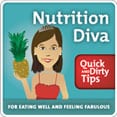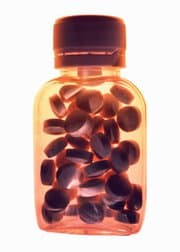One of the most electrifying sessions I attended at Andrew Weil’s Nutrition and Health Conference in April was one given by Dr. Michael Holick on Vitamin D. Dr Holick is a well-known, even notorious, name in nutrition research circles. He’s been insisting for years that vitamin D deficiency is far more wide-spread and dangerous than anyone realizes and he has a reputation (which he himself promotes!) of being a bit of a kook.
A few years ago, he was famously booted from the Boston University dermatology faculty for making heretical statements about the benefits of moderate UV exposure (which stimulates the production of vitamin D in the skin) and has been chided and derided by the dermatology establishment ever since.
I thought I had a pretty good idea of what to expect from Holick’s presentation; it would be all about the miraculous powers of vitamin D and the dire consequences of deficiency. I tend to take these sort of Wonder Nutrient presentations with a grain of salt. When you spend your whole life researching a single compound–like many of these researchers do, I think you can start to lose your sense of perspective. As the old saying goes: When you’re holding a hammer, everything starts to look like a nail.
The evidence is always reasonably compelling. And by the end of every Wonder Nutrient presentation, you find yourself thinking, I really should start taking that, and I should probably start recommending it to my patients, too. The problem is that after a few dozen of these presentations, you (and your patients) have a list of 40 nutrients that you “need” to be taking.
It’s probably a backlash against too many Wonder Nutrients but, as many of you know, I’m not all that big on dietary supplements. Whenever possible, I think it’s better to meet your nutritional needs with actual foods. I myself take very few supplements. And I have become immune to the persuasive power of Wonder Nutrient lectures.
And yet, after hearing Dr. Holick’s presentation, I literally stopped on my way back to the hotel to buy a bottle of vitamin D (1000IU).
First, I’ve gotta say, if you ever have a chance to see this guy speak, don’t miss it. All 1,200 of us in the audience were blown away (300 slides in 50 minutes). But it wasn’t just his over-the-top presentation that made me break my ban on Wonder Nutrients. It was the cumulative impact of the data.
To me, the most compelling reason why vitamin D is really in a category of its own, and why most people need far more vitamin D than they can ever get through their diet, is this: Our bodies were not designed to meet our vitamin D requirements through dietary sources–we evolved to produce vitamin D in our skin, when the sun hits it.
That’s why people who originally lived further from the equator have lighter skin–it allows more UV rays to penetrate, which compensates for the weaker rays at those latitudes. The traditional diet of the northern and southern latitudes is also more likely to include oily fish, the richest dietary source of vitamin D.
But now, most of us spend most the daylight hours indoors. Any skin that is showing is slathered in sunscreen to prevent skin cancer and wrinkles. We don’t eat much cod liver. We get most of our vitamin D from fortified dairy products and vitamin supplements, but it’s not nearly enough to meet our requirements.
Holick claims that the majority of Americans are chronically and dramatically D-deficient. Among those at particular risk are those with dark-skin, the elderly, the obese (because vitamin D tends to become trapped in fat cells) and anyone living about the 35th parallel (which runs through Arizona and Georgia). That is the latitude above which it is impossible to manufacture vitamin D in the winter months, even (as Holick to colorfully pointed out) you were to stand on the roof stark naked from noon to 3pm every day.
So what?
Every cell in the body has a receptor for vitamin D. Low blood levels of vitamin D are strongly linked to increased rates of cancer, osteoporosis, chronic pain syndromes, multiple sclerosis, rheumatoid arthritis, Type I diabetes, and hypertension.
In fact, if you chart deaths from colon cancer, prostate cancer, or multiple sclerosis geographically, you can pick out the 35th parallel by eye because the difference in mortality rates is so much higher above that line. (Deaths from multiple sclerosis are 100% higher above 37 N. than below it! )
There’s much more to Dr. Holick’s argument (about 280 slides worth) but suffice it to say, I’m a believer. Vitamin D is now one of only three nutrients I take as supplements (along with fish oil and calcium).
Dr. Holick and others are compaigning to have the government recommendations for vitamin D increased from the current recommendation of 200 – 600IU (depending on your age) to 1,000IU of vitamin D3 (cholecalciferol) for everyone. Based on his data, I support that recommendation.
Note: Vitamin supplements containing vitamin D2 (calciferol) are only about half as potent as D3 (cholecalciferol). Also, be cautious with sources that contain both vitamin D and vitamin A (such as supplements or cod liver oil) and be sure that the amount of vitamin A (retinol) that you’re getting from all sources does not exceed 10,000IU.
For more information on vitamin D and health, visit Dr. Holick’s site at http://vitamindhealth.org/


 Q. I’ve read a lot about the health benefits of Vitamin D. But isn’t there also a limit of how much Vitamin D I should supplement? Is there a danger or limit that avoids a possible toxic amount?
Q. I’ve read a lot about the health benefits of Vitamin D. But isn’t there also a limit of how much Vitamin D I should supplement? Is there a danger or limit that avoids a possible toxic amount?